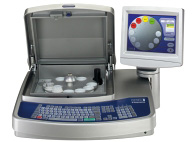Analysers Used To Reduce Hidden Hunger
Researchers use Oxford Instruments X-ray fluorescence (XRF) analysers on rice samples to reduce ‘hidden hunger’

Oxford Instruments Benchtop XRF AnalyserUsing Oxford Instruments benchtop XRF analyser the X-Supreme8000, researchers from Australian Flinders University found a faster, cheaper and more efficient way to determine the natural nutrient content of rice and pearl millet. This research will help farmers to develop more nutrious food crops that could reduce “hidden hunger”.
Hidden hunger is caused due to lack of zinc and iron in the diet. With rising poverty and growing population, grains like rice make up the biggest part of a diet for many people in the third world. Whilst rice provides the calories, it may lack vitamins and minerals leading to malnutrition. It is estimated that hidden hunger affects more than 2 billion people worldwide.
The researchers tested XRF technology to determine seeds which have a higher nutrient value. Oxford Instruments XRF benchtop analyser showed that this technology has several advantages. First, XRF analysis is much more cost efficient. Current analytical methods cost about $20 per sample while using XRF is as little as a couple of cents. Second, XRF analysers are extremely easy to use, with minimal training required and no complex sample preparation. Finally, XRF technology allows non-destructive analyses, which means tested seeds can be planted immediately if they show the desired nutrient value.
A recent study published in the journal Plant and Soil, demonstrates the high level of analytical accuracy and in field instrumentation proofs reliability of XRF technology for this application. Now, with support and funding of the organisation HarvestPlus, XRF technology is taken to third world countries to develop and deliver nutritious food crops. Oxford Instruments’ X-Supreme8000 benchtop analysers have been set up in research laboratories in countries such as Bangladesh, India, Mexico and the Philippines with more than 20 scientists trained to use the instruments.
“This application is a great demonstration of the numerous benefits associated with analysis using XRF, i.e. fast, accurate, simple to use. Further expansion of the use of XRF into other applications is expected”, says Neal Robson, Oxford Instruments Product Manager for XRF benchtop analysers“
CONTACT
Judith Friesl
Oxford Instruments Industrial Analysis
Judith.friesl@oxinst.com
www.oxford-instruments.com
+44 (0) 1494 479278
Thursday 22 March 2012 / file under Food and Beverage | Biotechnology | Agriculture



